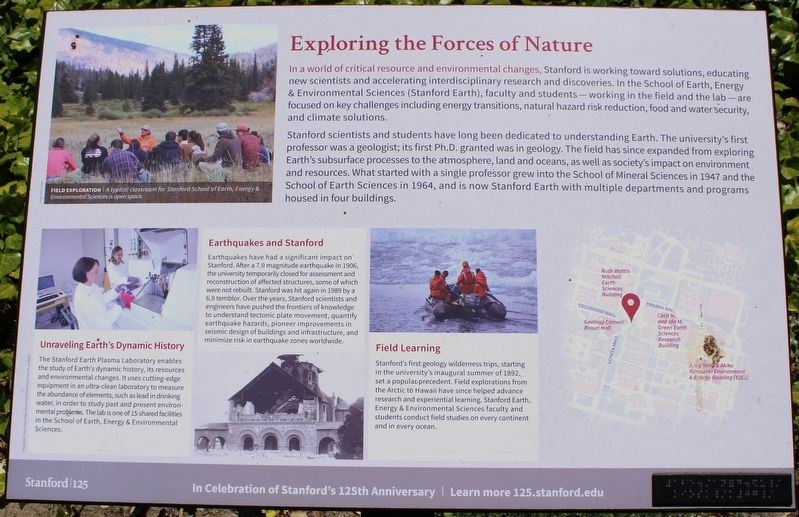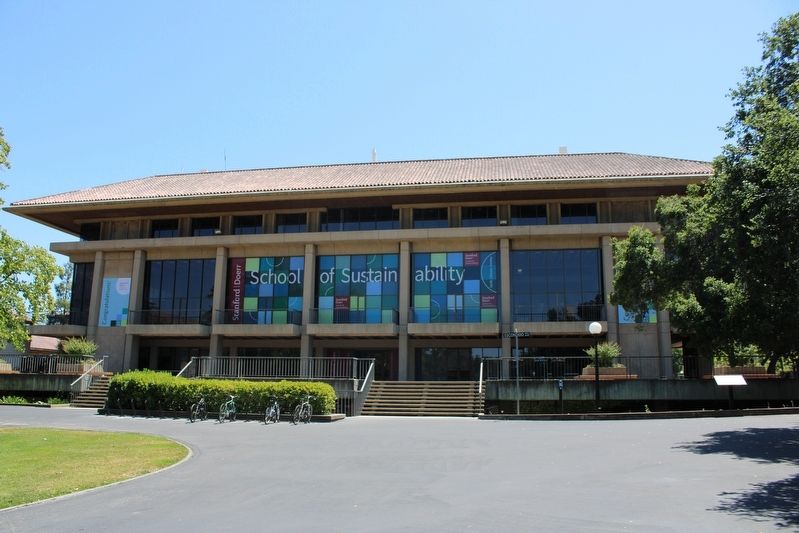Stanford in Santa Clara County, California — The American West (Pacific Coastal)
Exploring the Forces of Nature
Stanford scientists and students have long been dedicated to understanding Earth. The university's first professor was a geologist; its first Ph.D. granted was in geology. The field has since expanded from exploring Earth's subsurface processes to the atmosphere, land and oceans, as well as society's impact on environment and resources. What started with a single professor grew into the School of Mineral Sciences in 1947 and the School of Earth Sciences in 1964, and is now Stanford Earth with multiple departments and programs housed in four buildings.
Unraveling Earth's Dynamic History
The Stanford Earth Plasma Laboratory enables the study of Earth's dynamic history, its resources and environmental changes. It uses cutting-edge. equipment in an ultra-clean laboratory to measure the abundance of elements, such as lead in drinking water, in order to study past and present environmental problems. The lab is one of 15 shared facilities in the School of Earth, Energy & Environmental Sciences.
Earthquakes and Stanford
Earthquakes have had a significant impact on Stanford. After a 7.9 magnitude earthquake in 1906, the university temporarily closed for assessment and reconstruction of affected structures, some of which were not rebuilt. Stanford was hit again in 1989 by a 6.9 temblor. Over the years, Stanford scientists and engineers have pushed the frontiers of knowledge to understand tectonic plate movement, quantify earthquake hazards, pioneer improvements in seismic design of buildings and infrastructure, and minimize risk in earthquake zones worldwide.
Field Learning
Stanford's first geology wilderness trips, starting in the university's inaugural summer of 1892, set a popular precedent. Field explorations from the Arctic to Hawaii have since helped advance research and experiential learning. Stanford Earth, Energy & Environmental Sciences faculty and students conduct field studies on every continent and in every ocean.
In Celebration of Stanford's 125th Anniversary | Learn more 125.stanford.edu
Erected by Stanford University.
Topics. This historical marker is listed in these topic lists: Disasters
• Education • Exploration • Science & Medicine. A significant historical year for this entry is 1892.
Location. 37° 25.609′ N, 122° 10.365′ W. Marker is in Stanford, California, in Santa Clara County. Marker can be reached from the intersection of Panama Mall and Lomita Mall, on the right when traveling west. The resin marker is mounted to a metal post below the rear steps of the Ruth Wattis Mitchell Earth Sciences Building. Touch for map. Marker is at or near this postal address: 397 Panama Mall, Stanford CA 94305, United States of America. Touch for directions.
Other nearby markers. At least 8 other markers are within walking distance of this marker. In Pursuit of Breakthroughs (about 500 feet away, measured in a direct line); Nourishing the Whole Student (about 600 feet away); Papua New Guinea Sculpture Garden (about 800 feet away); Motion Picture Research Commemoration (approx. 0.2 miles away); Restoration of the Stanford Campus (approx. 0.2 miles away); The Burghers of Calais (approx. 0.2 miles away); The Stanford Women’s Clubhouse (approx. 0.2 miles away); James Grant Fergusson (approx. 0.2 miles away). Touch for a list and map of all markers in Stanford.
More about this marker. Inset Images:
Field Exploration | A typical classroom for Stanford School of Earth, Energy & Environmental Sciences is open space.
Images (left to right): Stacy Geiken, Stanford University Archives, Hannah-Joy Warren
Also see . . . A history of Stanford.
"When Jane Lathrop Stanford and railroad magnate and former California Gov. Leland Stanford lost their only child, Leland, Jr., to typhoid in 1884, they decided to build a university as the most fitting memorial, and deeded to it a large fortune that included the 8,180-acre Palo Alto stock farm that became the campus. They made their plans just as the modern research university was taking form."(Submitted on September 1, 2023, by Joseph Alvarado of Livermore, California.)
Credits. This page was last revised on September 1, 2023. It was originally submitted on September 1, 2023, by Joseph Alvarado of Livermore, California. This page has been viewed 70 times since then and 12 times this year. Photos: 1, 2. submitted on September 1, 2023, by Joseph Alvarado of Livermore, California.

